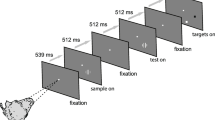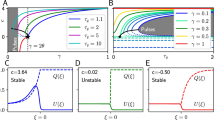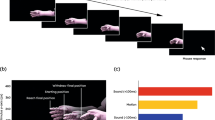Summary
To understand why some cells in the visual cortex respond to high stimulus velocities while others fail to do so, a sample of 71 of such cells were examined for their responses to stationary presented stimuli as well as to moving edges or slits of different widths. When presented with stationary stimuli it was found that cells which respond best to slowly moving stimuli generally have tonic discharges, long time to peak latencies and often long minimal durations of stimulation. In contrast, cells which respond preferentially to fast stimuli have phasic discharges, short latencies and short critical durations of stimulation when presented with stationary flashed slits. In the latter type of cells the responses to very fast stimulus movement were abolished selectively when contrast and width of the stimulus were not optimal. A few cells exhitited a velocity-response (VR) curve with a central dip indicating good responsiveness to either slow or fast movement but little to medium velocities. These cells responded both phasically and tonically to stationary slits and the latency of the tonic and phasic responses corresponded well to the latency of the responses at low and high velocities, respectively. It is suggested that the ability of phasic cells to respond to high velocities is linked to their limited need for temporal summation.
Similar content being viewed by others
References
Baker FH, Riva Sanseverino E, Lamarre Y, Poggio GF (1969) Excitatory responses of geniculate neurons of the cat. J Neurophysiol 32: 916–929
Bishop PO, Coombs JS, Henry GH (1971a) Responses to visual contours. Spatio-temporal aspects of excitation in the receptive fields of simple striate neurones. J Physiol (Lond) 219: 625–657
Bishop PO, Kozak W, Levick WR, Vakkur GJ (1962) The determination of the projection of the visual field on to the lateral geniculate nucleus in the cat. J Physiol (Lond) 163: 503–539
Cleland BG (1980) A comparison of the properties of the brisk-sustained (X) and brisk-transient (Y) cells in the retina of the cat. Exp Brain Res 41: A1-A2
Creutzfeldt OD, Kuhnt U, Benevento LA (1974) An intracellular analysis of visual cortical neurones to moving stimuli. Responses in a co-operative neuronal network. Exp Brain Res 21: 251–274
Dreher B, Hoffmann KP (1973) Properties of excitatory and inhibitory regions in the receptive fields of single units in the cat's superior colliculus. Exp Brain Res 16: 333–353
Dreher B, Sanderson KJ (1973) Receptive field analysis. Responses to moving visual contours by single lateral geniculate neurones in the cat. J Physiol (Lond) 234: 95–118
Duysens J, Orban GA (1981) Is stimulus movement of particular importance in the functioning of cat visual cortex? Brain Res 220: 184–187
Duysens J, Orban GA, van der Glas HW, de Zegher FE (1981a) Functional properties of area 19 as compared to area 17 of the cat. Brain Res (in press)
Duysens J, Orban GA, Verbeke O (1981b) Velocity sensitivity mechanisms in cat visual cortex. Arch Int Physiol Biochim 89: P39
Galletti C, Squatrito S, Maioli MG, Riva Sanseverino E (1979) Single unit responses to visual stimuli in cat cortical areas 17 and 18. II. Responses to stationary stimuli of variable duration. Arch Ital Biol 117: 231–247
Goodwin AW, Henry GH (1978) The influence of stimulus velocity on the responses of single neurons in the striate cortex. J Physiol (Lond) 277: 467–482
Grüsser OJ, Hellner KA, Grüsser-Cornehls U (1962) Die Informationsübertragung im afferenten visuellen System. Kybernetik 1: 175–192
Hamasaki DI, Cohen HI (1977) Differential response of X and Y retinal ganglion cells to moving stimuli results from a difference in the surround mechanism. Brain Res 122: 157–161
Henry GH (1977) Receptive field classes of cells in the striate cortex of the cat. Brain Res 133: 1–28
Hess R, Wolters W (1979) Responses of single cells in cat's lateral geniculate nucleus and area 17 to the velocity of moving visual stimuli. Exp Brain Res 34: 273–286
Ikeda H, Wright MJ (1975a) Spatial and temporal properties of “sustained” and “transient” neurones in area 17 of the cat's visual cortex. Exp Brain Res 22: 363–383
Ikeda H, Wright MJ (1975b) Retinotopic distribution, visual latency and orientation tuning of “sustained” and “transient” cortical neurones in area 17 of the cat. Exp Brain Res 22: 385–398
Kato H, Bishop PO, Orban GA (1978) Hypercomplex and the simple/complex cell classifications in cat striate cortex. J Neurophysiol 41: 1071–1095
Kelly JP, Van Essen DC (1974) Cell structure and function in the visual cortex of the cat. J Physiol (Lond) 238: 515–547
Levick WR, Zacks JL (1970) Responses of cat retinal ganglion cells to brief flashes of light. J. Physiol (Lond) 206: 677–700
Maes H, Orban GA (1980) STIMUL. Stimulus control and multihistogram analysis of single neurone recordings. Med Biol Eng Comp 18: 569–572
Movshon JA (1975) The velocity tuning of single units in cat striate cortex. J Physiol (Lond) 249: 445–468
Movshon JA, Thompson ID, Tolhurst DJ (1978) Receptive field organization of complex cells in the cat's striate cortex. J Physiol (Lond) 283: 79–99
Nikara T, Bishop PO, Pettigrew JD (1968) Analysis of retinal correspondence by studying receptive fields of binocular single units in cat striate cortex. Exp Brain Res 6: 353–372
Orban GA, Kennedy H (1981) The influence of eccentricity on receptive field types and orientation selectivity in areas 17 and 18 of the cat. Brain Res 208: 203–208
Orban GA, Hoffmann KP, Duysens J (1981a) Influence of stimulus velocity on LGN neurons. Soc Neurosci Abstr (in press)
Orban GA, Kennedy H, Maes H (1981b) Response to movement of neurons in areas 17 and 18 of the cat. Velocity sensitivity. J Neurophysiol 45: 1043–1058
Wolters W, Hess R (1975) The response of neurones in LGN and visual cortex of cats on different velocities of light stimuli. Pflügers Arch [Suppl R97] 355: 193
Author information
Authors and Affiliations
Additional information
Supported by an NFWO grant
Rights and permissions
About this article
Cite this article
Duysens, J., Orban, G.A. & Verbeke, O. Velocity sensitivity mechanisms in cat visual cortex. Exp Brain Res 45, 285–294 (1982). https://doi.org/10.1007/BF00235789
Received:
Issue Date:
DOI: https://doi.org/10.1007/BF00235789




